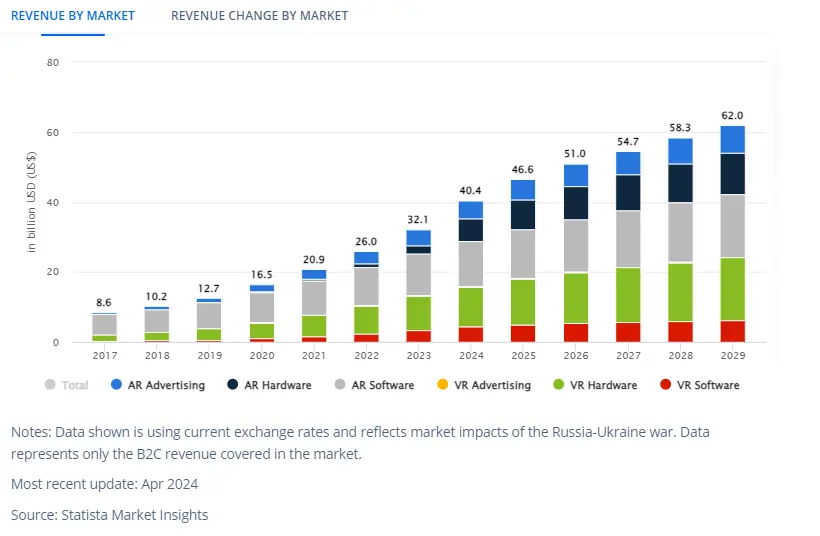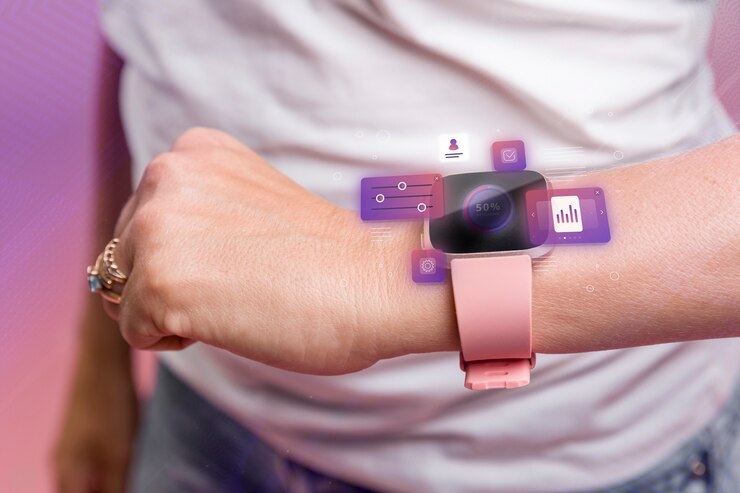Table of Contents
AR VR app development has witnessed tremendous growth in recent times due to technological advancements in augmented reality app development, virtual reality (VR), and metaverse development. AR VR application development companies offer hybrid app development services to create immersive and interactive experiences across devices.
The number of AR & VR market users is estimated to cross 3,728.0m users by 2029. AR/VR app development technologies can transform businesses across industries like education, healthcare, marketing, engineering, etc. However, developing high-quality AR VR applications requires expertise in fields like computer vision, spatial mapping, computer graphics, UI/UX design alongside core mobile app development skills.
Each year the AR & VR market now generates an approximately $32.1 billion. This article explores the pros and cons of AR VR app development to understand challenges and opportunities.

What You Must Know About AR VR Development?
Below are the aspects you must know about AR VR app development services. Check it out:
Development Process
The development process starts with understanding client requirements, creating wireframes and prototypes, designing interactive 3D environments, programming using ARCore/ARKit or Unity/Unreal game engines. Top AR VR solutions and AR app development companies focus on user research and testing prototypes iteratively. Developing for multiple platforms requires extra effort for cross-platform support.
Technical Expertise
AR VR technology revolution demands expertise in computer graphics, 3D modeling, physics engines, computer vision and sensors to seamlessly blend digital and physical worlds. Developers need training on tools like Unity, Unreal, Vuforia, ARCore etc. Finding skilled talent remains a challenge for many mobile app development companies USA.
Hardware Compatibility
Developing hardware-agnostic experiences requires accommodating diverse device capabilities impacting performance and features. Ensuring compatibility across mobile devices, tablets, VR/AR headsets increases testing and maintenance efforts for hybrid app development services.
3D Content Creation
Creating immersive 3D environments and realistic digital assets consumes significant time and effort of 3D artists, animators, level designers and more. Acquiring high-quality 3D content increases costs, particularly for education with AR/VR and training applications.
Steps To Follow For AR VR Development
1. Conceptualize and Storyboard
The first step involves extensive brainstorming and discussions between key stakeholders such as the client, mobile app development company in USA, designers and developers to understand project goals and scope. User profiles and personas are created along with blueprints of user flows and interactions within the virtual world. Paper prototypes and simple wireframes are developed to visualize ideas. Storyboards help flesh out the narrative experience by depicting scenes, user journeys and interactions through a sequence of images. Various hybrid app development services companies emphasize on user research and analyzing competitor offerings at this stage to refine concepts. Iterative user testing of prototypes helps refine ideas early on to align expectations.
2. Design Interfaces and Environments
Detailed visual design phase begins with creating 3D environments, assets, characters, textures, lighting effects and interactive elements in tools like Maya, Blender or 3Ds Max as per the vision. Interface design follows AR VR UX guidelines for intuitiveness. Design specifications cover visual style, proportions, mapping system, interactions etc. Environments are carefully modeled to be optimally performant on diverse target devices supported by mobile app development companies USA. Assets require quality texturing, lighting and animation to appear realistic for immersion. Interactions between digital and physical objects need simulations through physics controllers. Prototypes are developed allowing rapid iterative testing and feedback to refine the virtual world.
3. Develop Proof of Concept
After design, a basic functioning prototype is developed with key interactive features focused on core mechanics and technology feasibility using stock assets. Temporary art assets are leveraged for early iterations. Cross-platform support is tested through custom SDKs developed by enterprise app development companies on popular target platforms like iOS, Android, Windows etc. Technical challenges related to occlusion handling, tracking stability, graphics optimizations etc are addressed. Simple puzzles, mini-games or flows act as a proof of concept experience assessed internally and with select users. Valuable insights help prioritize development efforts. The proof of concept establishes technical and artistic vision while gathering early user sentiment to aid full development approach.
4. Choose Platform and Engine
Once conceptualized, the targeted device ecosystem and 3D game engine is selected based on features, budget and team’s expertise. While Unity and Unreal remain dominant, other options exist. Relative strengths and limitations of platforms like ARCore, ARKit, Windows MR etc are evaluated to finalize targets supported by mobile app development companies in USA services. Complex productions may require multiple engines. Factors considered include capabilities, scripting languages, asset import processes, physics systems, performance and scalability, integration of native platform APIs, pricing, documentation and community support. Engines help efficiently develop across targets leveraging reusable codebase and assets reducing development cycles and costs for hybrid app development services.
5. Import & Program Assets
High-fidelity 3D models, animations, textures and other visual assets finalized during the design phase get imported into the chosen engine. Precise setting of scale, positioning, materials, lighting significantly impacts visual quality, usability and performance compatibility with mobile devices. Programmable features include object interactions, physics, spatialized audio, particle effects via visual scripting or code. Entities get authored with behaviours defined through custom scripts extending their functionality. Rigging and skinning setup animations. Complex character movements require motion-matching. Unity’s visual scripting aids rapid iteration while C# programming delivers flexibility. Cross-platform AR templates help import and optimize artifacts natively across iOS, Android for versatile use later by VR app development company services.
Step into the Future—Start Developing with AR and VR!
6. Develop AR/VR Features
This involves programming AR specific aspects like environmental and object tracking, occlusion handling, hit-tests, scene understanding, lighting estimation etc leveraging capabilities like ARCore, ARKit for faithful visual placements supported by mobile app consulting in USA experts. Spatial mapping creates live 3D models of physical spaces for digital object anchoring. Rendering techniques maintain 60fps for low-latency experiences. VR aspects include 3D interactions, 360 video playback using technologies like VR SDKs and plugins. Foveated rendering optimizes graphics. Multiplayer VR allows collaborations within virtual worlds handled by enterprise app development companies’ proficient frameworks. Mixed reality brings AR and VR together handled through advanced game engine tools like Unity’s MRTK. Carefully developed features ensure immersion.
7. Test and Iterate
Thorough testing across diverse devices occurring throughout development aims to identify bugs, optimize performance, and enhance usability aided by testing services. Device capabilities, thermal profiles and networking are considered by mobile app development companies in the USA. User studies provide valuable feedback leading to experience refinements. A/B tests compare variations. Regular iterative cycles maintain a user-centered approach. Beta testing involves larger, more diverse sets finding replication issues. Localization and accessibility get evaluated to ensure global reach for education applications supported through mobile app consulting in USA. Analytics track KPIs aiding continuous improvements undertaken by data-driven best app development agencies in USA development practices.
8. Publish and Market
Applications get published through relevant distribution platforms upon fulfilling submission criteria of stores supported by various AR app development company services. Promotion strategies and marketing roadmaps involve social media campaigns, influencer outreach, cross-promotions, giveaways by PR agencies. Campaigns target relevant communities, geographic regions, influencers, and consumer groups based on personas. Partnerships, in-game incentives applied during soft launches aid organic installs. Localization expands the global consumer base. Business intelligence tools help optimize user acquisition costs and ROI. Post-launch roadmaps cater seamless content rollouts. Analytics optimize strategies through A/B tests executed by expert data teams of enterprise app development companies.
9. Continuous Improvement
Solving customer problems effectively and addressing ever-evolving landscapes require continuous innovation through iterative updates backed by relentless improvement cycles. Features requested via feedback channels add new value. Bugs get resolved attentively based on thorough testing. Performance optimizations ensure scalability. Analytics provide actionable insights to refinement areas, new opportunities through data-driven decision making undertaken by seasoned mobile app development companies USA experts. Enriching content maintains engagement. Security and data privacy enhancements focus on boosted trust. Regular communication with end-users aids understanding evolving needs. Measuring Vanity Metrics, Engagement and Monetization Metrics help benchmark successes for custom mobile app development services based projects and aid future roadmaps.
Features That Makes AR VR Development Proficient
Immersion
High fidelity graphics and lifelike visuals play a vital role in immersing users inside virtual worlds. AR VR applications developed by skilled mobile app development companies USA leverage the latest 3D modeling, texturing and rendering techniques to generate highly detailed realistic digital assets. Motion capture and procedural animation lend fluidity and believability to characters. Spatialized 3D audio instead of generic sounds enhances presence. Vibration feedback and wind simulation using haptics increase realism. Well-optimized applications maintain smooth 60fps on diverse hardware. Advanced rendering methods like foveated rendering ensure realistic imagery in the user’s peripheral and central vision. Photogrammetry scans actual spaces/objects for highest fidelity. Immersive features transport users, fostering long engagements for VR app development company created applications.
Interactivity
Intuitive real-time interactions are fundamental in AR VR. Gesture and gaze inputs facilitate natural manipulations of the virtual world. Customizable digital overlays interact with the physical environment analyzed in real-time through computer vision by AR app development services. Users touch, push or pull virtual objects blended seamlessly based on localization. Interactive animations react to a user’s proximity and movements. Physics simulations ensure objects behave realistically upon interactions.
Multi-touch interfaces make AR content easily shareable. Innovative interactions are continually prototyped and tested using mobile app consulting in USA expertise to boost engagements. Seamless blending of digital with physical through precise tracking techniques and interactive overlays magnify the experiential factor.
Collaboration
Social interactions and collaborations between distributed users are enabled within virtual spaces through multiplayer features. Users represented through avatars interact, swap virtual objects and complete cooperative activities. Communication channels facilitate real-time audio/video chat, messaging. Shared experiences bring communities closer despite physical distances increasingly important post-pandemic as emphasized by hybrid app development services companies. Gather functionality allows spontaneity. Integrations with social platforms aid virality while preserving privacy. Collaborative games, training and mixed realities developed by mobile app development companies USA for remote assistance break barriers through shared persistent virtual spaces.
Device Agnostic
Developing solutions compatible across platforms is a prime capability demanded by vertical agnostic clients as assisted through expert mobile app consulting in USA firms. Hybrid frameworks like Unity, Unreal supported by multiple platforms including desktop, web, mobile are leveraged to build cross-platform AR VR solutions in a synchronized codebase at marginal costs compared to native development. Write Once, Run Everywhere capabilities ensure engaging experiences for businesses across sectors reaching diverse audience profiles irrespective of their device ownership as empowered through top mobile app development companies USA skills. Seamless access anywhere supports freedom of interactions for truly immersive lifelike omnichannel engagements.
Integrations
Seamless interoperability with external services and systems broadens applications’ scope. E-commerce integrations power virtual storefronts and drive real transactions. APIs help data visualization, live monitoring integrations for industries. Authentication using social Login improves discoverability. Genuine inclusion of payment solutions facilitates optimized in-app monetization handled by on demand app development company experts proficiently. Integrations with IoT devices trigger actions based on sensor data. Travel apps book flights directly. CRM integrations enable streamlined workflows developed to scale by USA based top enterprise app development companies. Advanced integrations highly optimize experiences across platforms.
Localization
Globalization remains a focus for VR app development companies to attract international users. Support for multiple languages facilitates localization of interfaces, text assets, voiceovers accurately reflecting local preferences and nuances. Right-to-left text layout for Arabic and Hebrew. Cultural adaptations suit regional tastes. Currency/number format localization suits local standards. Translations leverage professional translation services to eliminate miscommunication. Leveraging globalization platforms simplify adding/managing languages competently handled by dedicated localization teams of professional mobile app development company in USA. Careful localization expands global markets for AR VR solutions created to optimize quality engagements through informed choices wherever users are located.
Monetization
Early-stage AR VR applications require monetization strategies for long term sustainability as carefully executed by expert on demand app development company teams. Advertising formats suit immersive placements. Well-placed sponsored gamified content engages users while generating revenue. Virtual/cloud items inspire purchases via online/app stores. Freemium allows full access upon subscriptions/unlocks. Revenue sharing boosts creator/developer earnings. Merchandise tie-ins expand into physical retail driving recurring incomes as proficiently handled through strategic integrations with payment service providers by top USA based enterprise app development firms. Insightful usage analytics optimize profitable monetization avenues.
Analytics
Collecting, analyzing and actioning usage insights gathered through integrated analytics systems optimizes experiences and enhances ROI for VR app development company created products. Event tracking via SDKs understands user flows. Session recordings via cloud services help bug detection. Click heatmaps to highlight friction points. Retention, engagement and other key metrics benchmark success benchmarks. Cohort studies help funnelling strategies. Built-in feedback options better address problems at scale. Integrated CRM platforms facilitate personalized communications. Benchmarking against competitors aids testing hypotheses most effectively through intelligent iterative optimizations and enhancements expertly managed by diligent analytics teams of leading custom mobile app development services firms.
Customization
B2B focused solutions require scalable admin controls for personalized configurations as aptly addressed through hybrid mobile app development services. Tailorable interfaces allow white-labelling as per client’s brand identity. User authentication & authorization mechanisms facilitate selective access. Profile-specific customizations provide unique experiences facilitating effective use in enterprises assisted through the expertise of top mobile app development companies in the USA. Configurable database fields aid flexible data handling. Rules-based logic tailor engagements based on predefined criteria. Hot-swappable components enable swift edits and A/B tests. API integrations bring 3rd party integrations under centralized management by esteemed enterprise app development companies through their proven proficient procedures.
Costing of AR VR Development
Cost depends on various factors like platform, features, complexity, expertise and scope of AR VR app development company services in metaverse or hybrid realities.
Basic App – $30,000 to $70,000
Covers basic prototype with 2-3 features on a single platform.
Complex App – $100,000 to $300,000
Advanced features, multiplayer, 3D assets etc. Targeting 2+ platforms increases cost.
Very Complex App – $500,000 and above
Massive 3D worlds, realistic graphics, physics, social VR features and premium customization require high investments.
Recurrent Costs
Regular updates, hosting, quality assurance, maintenance and support services contribute ongoing costs managed through monthly retainer fees or subscriptions by on demand app development companies.
In-House vs Outsourcing
Hiring experts or outsourcing mobile app developers in the USA for specialized skills proves more affordable compared to full in-house development teams.
Book 30 Minutes Free Consultations with A3Logics Experts to Start Your App Journey Today!
Final Thoughts
To conclude, AR VR exhibits huge potential across domains, but developing cutting-edge experiences requires optimizing processes, addressing technical complexities and aligning budgets. With advancing technologies, costs will decrease over time. Focusing on user needs, iterative approach, high production values and insightful analytics are success keys for companies like VR app development company. AR VR promises transformative impact in how we learn, work and socialize in the metaverse development. Backed by continual innovations, it will remain a thriving avenue for innovation, creativity and meaningful customer engagements.
FAQs
What challenges are encountered in AR VR development?
Key challenges include lengthy development cycles, hardware limitations, high costs, lack of standardization, ensuring seamless tracking and interactions.
How can costs be optimized?
Reusable 3D assets, outsourcing non-core work, cloud hosting, multi-platform development, agile processes, stock elements help reduce budgets for best VR apps.
What performance issues occur?
Lag spikes, reduced frame rates, overheating and drained battery life are common on under-powered devices due constraints related to intensive graphics and computational demands of AR VR experiences.
Which programming languages are used?
C/C++, C#, Unity’s C#, Java, JavaScript, TypeScript, Python etc. depending on target platform and game engine like Unity or Unreal being leveraged by custom mobile app development services.
How quickly is the market growing?
Global AR VR market is estimated to grow from $12 billion in 2018 to over $200 billion by 2025 propelled by expanding 5G availability, increased investment and evolving use cases across sectors including education, healthcare, retail, real estate with the maturing AR VR app development in metaverse ecosystem.







